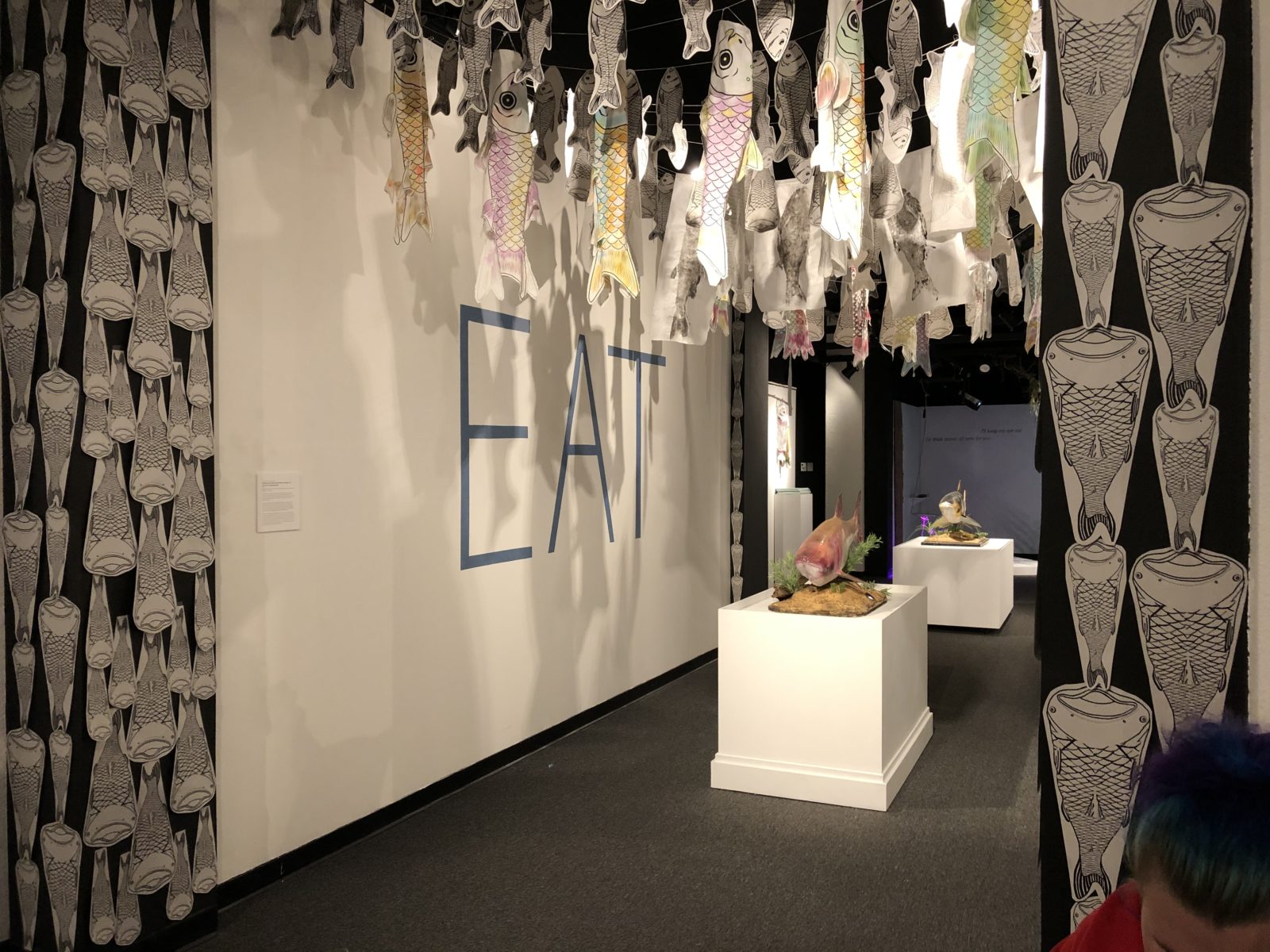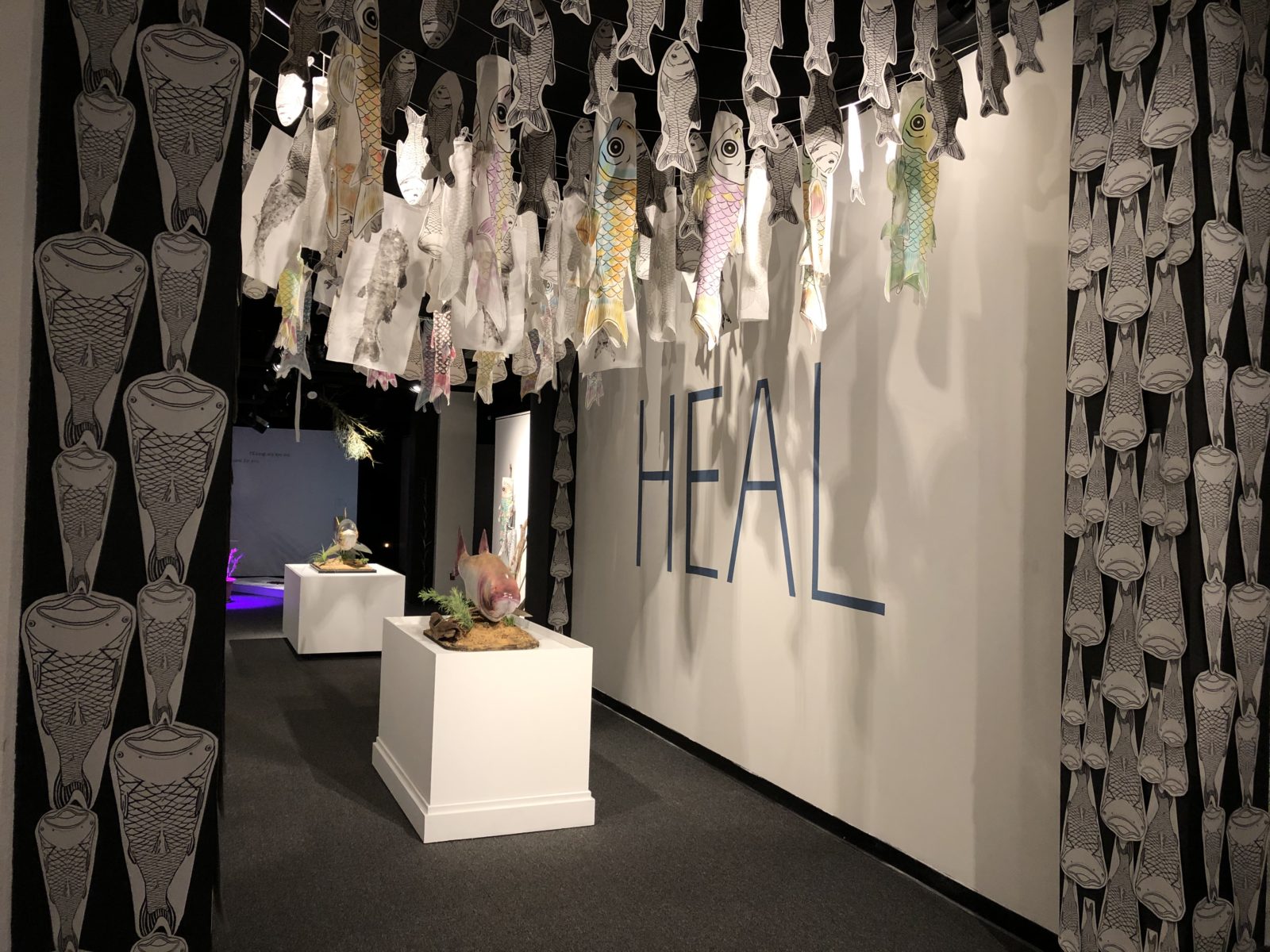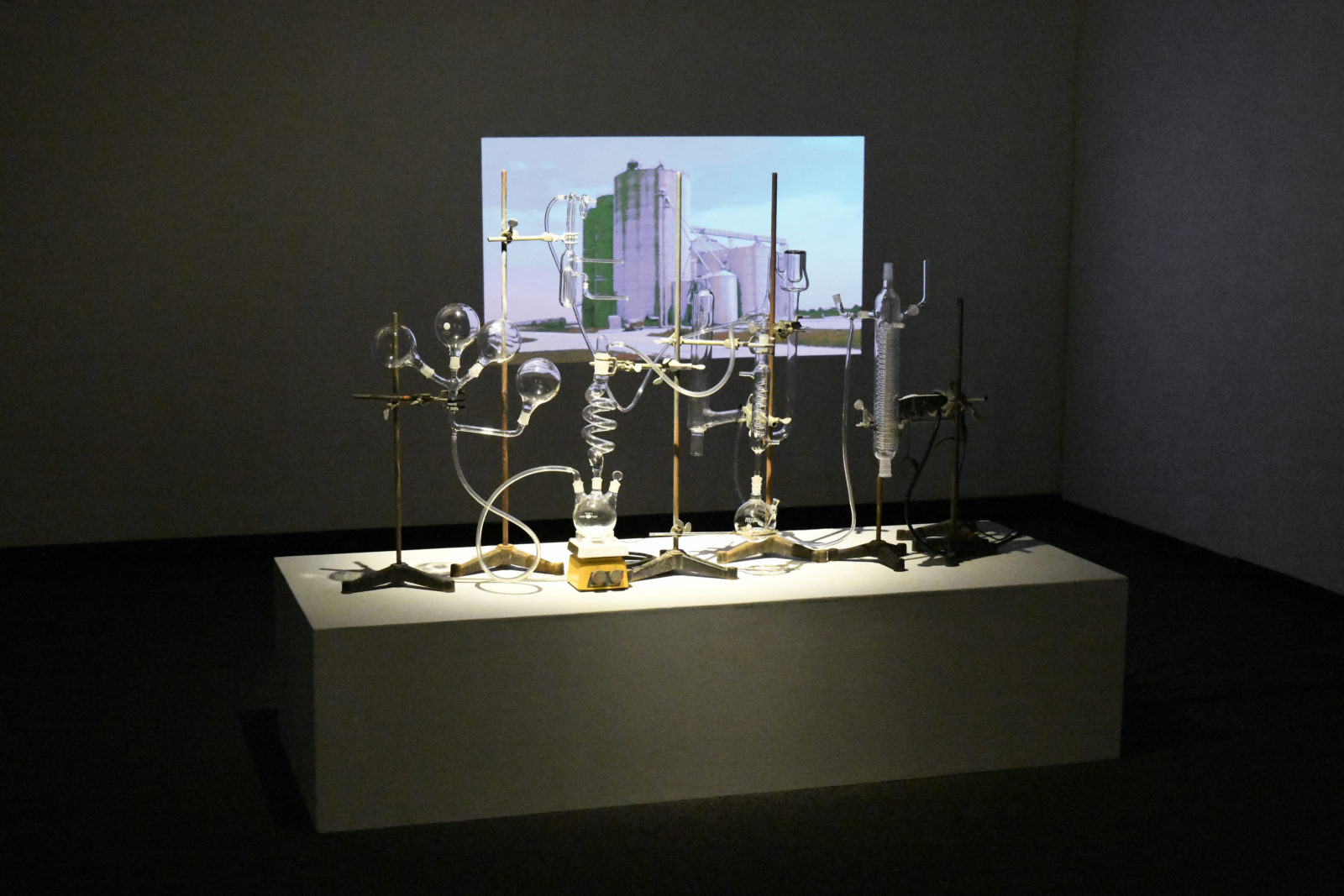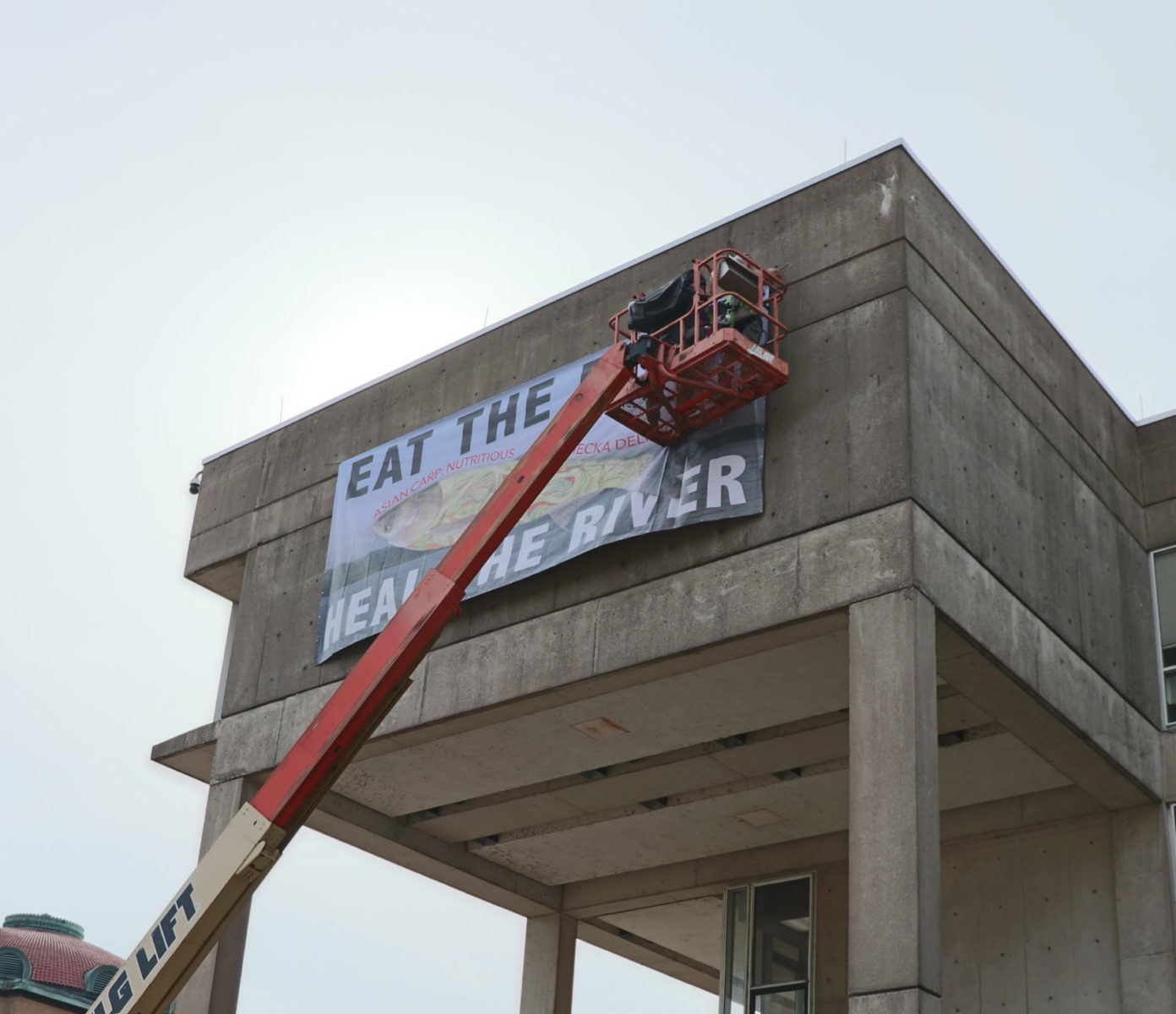Confluence Ecologies Exhibition
The Anthropocene in a Regional Nutshell
What can aesthetic regionalism tell us about the site-specific manifestations of the Anthropocene? In this piece, Brian Holmes reflects on the artistic expressions of the exhibition “Confluences Ecologies,” held at the Southern Illinois University Museum, exploring the shifting ecologies of the Confluence territory.
What does aesthetic regionalism become when it meets the concerns of the Anthropocene? The short answer is that artists start exploring the more-than-human destinies of a set of land- and waterscapes evolving over diverse scales of time. A somewhat longer and more sensitive collection of responses emerges from the exhibition Confluence Ecologies.
Fish people would have loved this show. After all, they could float through a kind of temple architecture festooned with images of invasive Asian carp, before being invited onto a woven willow boat evoking an imaginary voyage through a mostly disappeared swamp. Entitled Reshaping the Shape, the carp installation addresses human visitors directly, but as animals. Faced with the uncontrollable spread of a giant new jumping fish that is replacing the German carp of old, artists Sarah Lewison and Andy Yang suggest that instead of getting all nervous and nationalistic about it, why don’t you just eat ‘em? At stake here is a biological or “creaturely” relationship with the Confluence region. Michael Swierz and Maureen Walwrath offer a similar idea with their woven and hide-covered coracle boat: go out paddling under your own power into the swamp, to find occasional surviving remnants of the great canebrakes that early settlers cut down, just because they were in the way. The title of their work is This Is Not About Survival (It’s About Bringing Your Coracle). Again it’s a message of participatory ecology: in the ‘zine that accompanies the installation, the artists propose that you could selectively harvest and replant those rhizomatic beings yourself, to remake the brake in the present. But what could all that cane be good for, one might wonder? Well, first of all, for fishing poles!
Fish seek deep dark protected places in the river for shelter, and as for humans in this area, even today they like to dig. Inheritance, which is the name of a documentary piece with too many authors to list, plunges you into a totally dark space to hear mostly women’s voices telling tales from underground. These miners, both retired and still active, describe such things as the distinctive smell of the coal seam, the ancient scaly leafless trees you might see falling in pieces from the ceiling, or in one particularly terrifying case, the deadly methane explosions that propagate in muffled blasts through the mine. Like a kind of living photo-paper in the darkroom, your imagination is exposed to intensive flashes of geology, labor relations, unemployment worries, group solidarities, on-the-job injuries, and ancient fossils, all of which is then symbolically served up to you on silver platters atop a mysteriously floating table in an adjoining gallery. On the night of the opening, a couple of the miners sat in the darkness listening to their own chthonic voices, wondering aloud about the meaning of what they do. It was a spooky moment that brought them very close to the concerns of the artists, who are obsessed with something called the Keeling Curve that shows the peaks and valleys of atmospheric CO2 levels over geological time.
"Inheritance" by Kayla Anderson, Sara Black, Amber Ginsburg, Sarah Lewison, Claire Pentecost. Photo by Sarah Lewison Detail from "Inheritance" by Kayla Anderson, Sara Black, Amber Ginsburg, Sarah Lewison, Claire Pentecost. Photo by Sarah Lewison
Every contemporary art exhibition includes a plethora of videos, and this one is no exception. But a twist is added from the outset by Hopium Economy: The Chemist and the Breacher, by the artist duo Geissler & Sann. Their work splices footage from the agricultural Midwest into two distinct video recordings of a performance piece. The video is then projected in a gallery that contains a complex scientific installation, created with significant support from the chemistry lab at the University of Illinois Chicago. In the video, actors recite carefully composed scripts based on real-life interviews and other materials that have been recombined for dramatic effect. The resulting narratives deal with the highly addictive uses of industrially produced nitrogen, whether for bombs, fertilizers, or home-cooked methamphetamines. Like Inheritance, this work attempts to understand how civilizational relationships with organic compounds are disrupting ecological cycles, through all-too-human outbursts of consuming passion. But the reveal at the end of the piece switches geographical rather than temporal scales. In a post-scriptum, the artists note that the laboratory glassware arrayed on a pedestal in front of the video projection is a more or less faithful replica of a similar display in a museum in Munich, memorializing the Haber-Bosch synthesis of industrial nitrogen in Germany in the years leading up to the First World War. The global history of technology is also a history of the local environment, and even of the psyche.
"HOPIUM ECONOMY Substance Dependencies in the Anthropocene" by Beate Geissler / Oliver Sann. Photo by Sarah Lewison
Born Secret (Cash for Kryptonite) is another multi-authored video that brings techno-economic history right up the present, by following the visual record of hydropower development in the nearby Tennessee River Basin. That story begins in the Great Depression of the 1930s, intersects with the military brass of the Manhattan Project during the Second World War, then spills over into a massive uranium-enrichment plant very close to the confluence of the Ohio and Mississippi Rivers in the 1950s. Through this lens, highly abstract concepts like the “technosphere” or the “Great Acceleration” take on specific regional forms. In the video, these concepts get bound up with the festive tourist celebration of Superman in his own registered birthplace, the nearby uranium-processing town of Metropolis, Illinois. A scintillating image, an implacable text, and an out-of-this-world soundtrack make up a three-part dissonant harmony that keeps asking insistent questions: Why super powers? What is that mysterious green stone? Where lies the hidden weakness?
The concept of the Anthropocene, like the Earth system science that produced it, inevitably becomes a world view. Scientists obtain this world view through orbiting telescopes focused not on the stars, but on our own terrestrial skin. A novelist like Kim Stanley Robinson can go much further, metaphorically transporting himself to Mars. Taking this cue, the video Timeslips by Jay Alan Yim, Marlena Novak, and Joslyn Willauer presents the voice, the viewpoint, and the acoustic imaginary of a future agronomist who has emigrated to the Red Planet and now looks back bemusedly on her early life among the barbaric societies of a ruined Earth. Many good ideas sprang from that disastrous beginning, to be sure: like an entirely new kind of aerial agriculture that is watered, fertilized, and monitored by drones, leaving room for unlimited ecological diversity on the ground. But the memories of the Blue Planet are also dark and turbulent like a Midwestern tornado (or is it a Martian twister? Some doubt about the accuracy of the agronomist’s memory creeps in). Astonishing musical compositions transport you into affective landscapes of that dark past, while the woman’s futuristic gaze continually breaks up into a cybernetic scrim that tears at the conventional flatness of the image. Startling transitions between the Confluence region and the Danube river valley in Austria lend yet further visual force to this piece, which is almost as deterritorializing as contemporary experience.
The poet William Blake saw the universe in a grain of sand, and this exhibition puts the Anthropocene in a regional nutshell. The kernel was right there for all to see, just outside the building that housed the show. A billboard-size image of a leaping Asian carp proclaimed “EAT THE RIVER, HEAL THE RIVER.” That’s an interspecies philosophy of reciprocal adaptation, in the spirit of everything ecologists know about population dynamics and co-evolution. Below it was a more ironic sculptural installation by Jeremy Bolen and Jenny Kendler, built up of a pyramid of lifesaving rings. Normally red-orange, they were repainted for the occasion with a perplexing commercial shade called “climate change white.” The equally white lounge chair perched atop these lifesavers seems to sum up the predominant American attitude to environmental disaster foretold. Just like present-day inhabitants behind the Mississippi levees, this floating sculpture is Lounging through the Flood.
Photo by Sarah Lewison
Confluence Ecologies was on show at Southern Illinois University Museum from October 11 to November 20, 2019.





